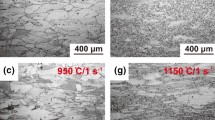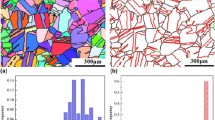The method of orientation microscopy (EBSD) is used to study the structural and textural states of a nickel-base Ni – Cr – Mo alloy after cold rolling and subsequent annealing. It is shown that the deformation yields a multicomponent rolling texture. The Σ3 special boundary formed at the start of the deformation process is preserved after the deformation as a stable-energy object. Recrystallization yields a crystallographic texture, the main components of which are associated with the strain orientations through special off-orientations.




Similar content being viewed by others
References
Wanjun Hu, Rui Hu, and Xiangyu Gao, “Evolution of Σ3n CSL boundaries in Ni – Cr – Mo alloy during aging treatment,” Mater. Charact., 134, 379 – 386 (2017).
A. Goyal (ed.), Second-Generation Current-Conducting Ribbons of Based on High-Temperature Superconductors [in Russian], Izd. LKI, Moscow (2010), 432 p.
D. P. Rodionov, I. V. Gervas’eva, and Yu. V. Khlebnikova, “Substrate ribbons with cubic texture from ternary NiCrMe (Me = W, Mo, V) for second-generation superconducting cables,” Fiz. Met. Metalloved., 113(5), 532 – 541 (2012).
Ya. D. Vishnyakov, A. A. Babareko, S. A. Vladimirov, and I. V. Égiz, The Theory of Texture Formation in Metals and Alloys [in Russian], Nauka, Moscow (1979), 329 p.
R. Penelle and T. Baudin, “Primary recrystallization of invar, Fe – 36% Ni alloy: Origin and development of the cubic texture,” Adv. Eng. Mater., 12, 1047 – 1052 (2010) (DOI: https://doi.org/10.1002/adem.201000077).
Y. V. Khlebnikova, D. P. Rodionov, I. V. Gervas’eva, et al., “Perfect cubic texture, structure, and mechanical properties of nonmagnetic copper-based alloy ribbon substrates,” Tech. Phys., 60, 389 – 399 (2015) (DOI: https://doi.org/10.1134/S1063784215).
M. A. Zorina, M. L. Lobanov, E. A. Makarova, and G. M. Rusakov, “Primary recrystallization texture in fcc-metal with low packing defect energy,” Met. Sci. Heat Treat., 60, 329 – 336 (2018) (DOI: https://doi.org/10.1007/s11041-018-0280-8).
H. Paul and M. M. Miszczyk, “Deformation microstructure and texture transformation in the fcc metals of medium-to-high stacking fault energy: critical role of micro- and macro-scale shear bands,” Arch. Metall. Mater., 60, 2235 – 2246 (2015) (DOI: https://doi.org/10.1515/amm-2015-0369).
M. A. Zorina, M. S. Karabanalov, S. I. Stepanov, et al., “Fiber vs rolling texture: Stress state dependence for cold-drawn wire,” Metall. Mater. Trans. A, 49, 427 – 433 (2018) (DOI: https://doi.org/10.1007/s11661-017-4423-0).
F. J. Humphreys and M. Hatherly, Recrystallization and Related Annealing Phenomena, Elsevier Ltd., Oxford (2004), 524 p.
M. L. Lobanov, S. V. Danilov, V. I. Pastukhov, et al., “The crystallographic relationship of molybdenum textures after hot rolling and recrystallization,” Mater. Des., 109, 251 – 255 (2016).
M. L. Lobanov, and S. V. Danilov, “Interrelation between orientations of deformation and recrystallization in hot rolling of anisotropic electrical steel,” Met. Sci. Heat Treat., 57(7 – 8), 492 – 497 (2015).
A. A. Redikul’tsev, M. L. Lobanov, G. M. Rusakov, and L. V. Lobanova, “Secondary recrystallization in Fe – 3% Si alloywith (100)[001] single-component texture,” Phys. Met. Metallogr., 114(1), 33 – 40 (2013).
A. A. Babareko, Development of Texture in Metals and Alloys under Deformation Recrystallization [in Russian], Metallurgiya, Moscow (1967), pp. 5 – 83.
A. Tuissi, E. Villa, M. Zamboni, et al., “Biaxially textured NiCrX (X = W and V) tapes as substrates for HTS coated conductor applications,” Physica C, Supercond. Appl., 372 – 376, Pt. 2, 759 – 762 (2002).
A. P. Shlyamnev, T. V. Svistunova, O. B. Lapshina, et al., Corrosion-Resistant, Refractory and High-Strength Alloys [in Russian], Intermet Engineering, Moscow (2000), 232 p.
W. Y. Yeung and B. J. Duggan, “Shear band angles in rolled F.C.C. materials,” Acta Metall., 35, 541 – 548 (DOI: https://doi.org/10.1016/0001-6160(87)90259-8).
H. Paul, J. H. Driver, and Z. Jasieñski, “Shear banding and recrystallization nucleation in a Cu – 2% Al alloy single crystal,” Acta Mater., 50, 815 – 830 (2002) (DOI: https://doi.org/10.1016/S1359-6454(01)00381-0).
J. F. W. Bishop and R. Hill, “A theory of plastic distortion of a polycrystalline aggregate under combined stresses,” Philos. Mag., 42, 414 – 427 (1951).
M. Hölscher, D. Raabe, and K. Lücke, “Relationship between rolling textures and shear textures in f.c.c. and b.c.c. metals,” Acta Metall. Maer., 42(3), 879 – 886 (1994) (DOI: https://doi.org/10.1016/0956-7151(94)90283-6).
M. L. Lobanov, Yu. N. Loginov, S. V. Danilov, et al., “Effect of hot rolling rate on the structure and texture condition of plates of the Al – Si – Mg alloy system,” Met. Sci. Heat Treat., 60, 322 – 328 (2018) (DOI: https://doi.org/10.1007/s11041-018-0279-1).
P. Wagner, O. Engker, and K. Lücke, “Formation of Cu-type shear bands and their influence on deformation and texture of rolled f.c.c. {111}〈112〉 single crystals,” Acta Metal. Mater., 43, 3799 – 3812 (1995) (DOI: https://doi.org/10.1016/0956-7151(95)90164-7).
G. M. Rusakov, A. A. Redikultsev, and M. L. Lobanov, “Formation mechanism for the orientation relationship between {110}〈001〉 and {111}〈112〉 grains during twinning in Fe – 3 pct Si alloy,” Metall. Mater. Trans. A, 39, 2278 – 2280 (2008) (DOI: https://doi.org/10.1007/s11661-008-9575-5).
G. M. Rusakov, A. A. Redikul’tsev, M. L. Lobanov, and A. I. Gomzikov, “On the possibility of formation of domains with {110}〈001〉 orientation during cold deformation of commercial Fe – 3% Si alloy,” Phys. Met. Metall., 101, 600 – 606 (2006) (DOI: https://doi.org/10.1134/S0031918X06060135).
H. Yan, X. Zhao, N. Jia, et al., “Influence of shear banding on the formation of brass-type textures in polycrystals of fcc metals with low stacking fault energy,” J. Mater. Sci. Technol., 30, 408 – 416 (2014) (DOI: https://doi.org/10.1016/j.jmst.2013.11.010).
G. M. Rusakov, M. L. Lobanov, A. S. Redikul’tsev, and I. V. Kagan, “Specific features of cold deformation of a (110)[001] single crystal of an Fe – 3% Si –0.5% Cu alloy related to twinning,” Phys. Met. Metalloved., 111, 530 – 536 (2011) (DOI: https://doi.org/10.1134/S0031918X11040119).
G. M. Rusakov, M. L. Lobanov, A. S. Redikultsev, and I. V. Kagan, “Retention of the twinning Σ3 disorientation in the process of lattice transformation during cold rolling of a Fe3pctSi single crystal,” Metall. Mater. Trans. A, 42, 1435 – 1438 (2011) (DOI: https://doi.org/10.1007/s11661-011-0684-1).
A. Albou, M. Galcerun, K. Renard, et al., “Nanoscale characterization of the evolution of the twin-matrix orientation in Fe – Mn – C twinning-induced plasticity steel by means of transmission electron microscopy orientation mapping,” Scr. Mater., 68, 400 – 403 (2013) (DOI: https://doi.org/10.1016/j.scriptamat.2012.10.052).
M. A. Zorina, S. V. Danilov, G.M. Rusakov, and M. L. Lobanov, “Interrelation between textures of deformation and recrystallization in commercially pure aluminum,” Vest. Yuzhno-Uralsk. Gos. Univers., Ser. Metallurgiya, 17(3), 73 – 81 (2017).
The work has been performed with support of the Russian Scientific Foundation (Grant 18-79-00126).
Author information
Authors and Affiliations
Corresponding author
Additional information
Translated from Metallovedenie i Termicheskaya Obrabotka Metallov, No. 7, pp. 50 – 55, July, 2020.
Rights and permissions
About this article
Cite this article
Zorina, M.A., Zhilyakov, A.Y. & Karabanalov, M.S. Crystallographic Textures of Strain and Recrystallization in a Superalloy of the Ni – Cr – Mo System. Met Sci Heat Treat 62, 469–474 (2020). https://doi.org/10.1007/s11041-020-00586-1
Published:
Issue Date:
DOI: https://doi.org/10.1007/s11041-020-00586-1




